Вальцовочные станки - это универсальные и эффективные производственные инструменты, используемые в различных отраслях промышленности. Эти машины играют решающую роль в формировании металлических листов в желаемые профили с высокой точностью и повторяемостью. Постепенно изгибая металл через серию валков, валковые машины могут производить непрерывные профили равномерного сечения.
1. Введение
Вальцовочные станки произвели революцию в металлообрабатывающей промышленности, предлагая экономически эффективное решение для массового производства металлических компонентов. Будь то строительство, автомобилестроение или другие отрасли, эти машины стали незаменимыми в производственных процессах. В этой статье мы рассмотрим различные типы вальцовочных станков и их применение, уделяя особое внимание двухслойным вальцовочным станкам, фризовым вальцовочным станкам, облицовочным вальцовочным станкам, окладочным вальцовочным станкам и вальцовочным станкам для настила пола.

2. Обзор валковых формовочных машин
Прежде чем перейти к рассмотрению конкретных типов, давайте разберемся в основном принципе работы и компонентах вальцовочных станков. Вальцовочная машина состоит из ряда валков, также известных как валковые станции, установленных на валах. Эти валки постепенно придают металлической полосе форму по мере ее прохождения через машину. Металлическая полоса подается в машину и проходит через различные этапы, где каждый валок выполняет определенную операцию гибки или формовки. Конечным продуктом является непрерывный металлический профиль с постоянным поперечным сечением.
Принцип работы валковых формовочных машин
Вальцовочные станки используют непрерывный процесс гибки для придания формы металлическим листам. По мере прохождения металлической полосы через машину, она постепенно изгибается и формируется последовательными станциями вальцовки. Каждая валковая станция оснащена набором валков, которые постепенно деформируют металлическую полосу, постепенно превращая ее в нужный профиль. Количество и расположение валковых станций зависит от сложности профиля.
Компоненты рулона
Формовочная машина Вальцовочная машина состоит из нескольких основных компонентов, которые работают вместе для обеспечения бесперебойной и эффективной работы:
- Разматыватель: Этот компонент удерживает рулон металла и подает полосу в рулоноформовочную машину. Он разматывает рулон контролируемым образом, обеспечивая непрерывную подачу материала.
- Система кормления: Система подачи транспортирует металлическую полосу от разматывателя к первой станции прокатки. Она обеспечивает правильное выравнивание и плавное перемещение полосы в процессе формовки.
- Роликовые станции: Валковые станции состоят из ряда валков, установленных на валах. Каждый валок выполняет определенную операцию гибки или формовки металлической полосы по мере ее прохождения. Валки предназначены для постепенного придания полосе требуемого профиля.
- Механизм резки: В некоторых вальцепрокатных станках для отделения готовых профилей от непрерывной полосы используется механизм резки. Это может быть летучая отсечка, гидравлические ножницы или другие методы резки в зависимости от требований.
- Система контроля: Система управления управляет общей работой вальцепрокатного станка. Она регулирует скорость, процессы подачи и резки, обеспечивая точное и последовательное формирование профилей.
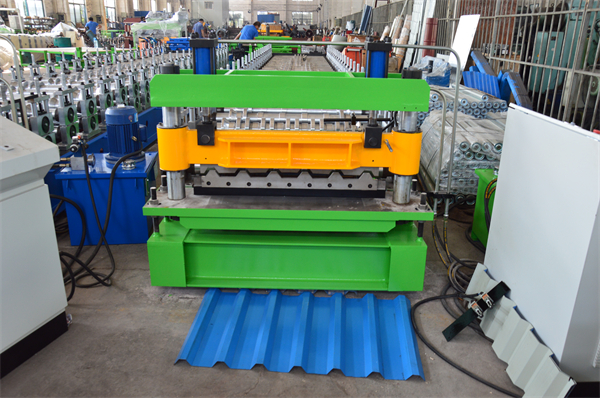
3. Двухслойная рулонная формовочная машина
Введение в двухслойную роликоформовочную машину
Двухслойная вальцовочная машина - это специализированный тип вальцовочного оборудования, позволяющий одновременно производить два различных профиля. Она состоит из двух независимых валковых линий, расположенных вертикально, причем каждая линия предназначена для формирования определенного профиля. Такое оборудование обеспечивает повышенную производительность и универсальность, что делает его идеальным для отраслей, требующих изготовления нескольких профилей.
Рабочий процесс и особенности
Рабочий процесс двухслойной вальцовочной машины включает в себя подачу двух отдельных металлических полос на соответствующие линии вальцевания. Каждая линия работает независимо, полосы проходят через специальные вальцовочные станции. Конечным результатом являются два непрерывных профиля различных форм и размеров.
Примечательной особенностью двухслойной вальцовочной машины является возможность быстрой переналадки. Она позволяет быстро переходить от одной установки профиля к другой, минимизируя время простоя и максимизируя производительность. Машина оснащена регулируемыми подставками для валков и оснасткой, что позволяет легко настраивать и регулировать ее в соответствии с конкретными требованиями к профилю.
Применение и преимущества
Двухслойные рулоноформовочные машины находят широкое применение в таких отраслях, как кровельная, строительная и автомобильная, где для различных применений требуется несколько профилей. Некоторые распространенные области применения включают кровельные панели, облицовку стен, гаражные ворота, системы перегородок и многое другое.
Основные преимущества использования двухслойной вальцовочной машины включают:
- Повышенная эффективность: Благодаря возможности одновременного производства двух различных профилей, станок обеспечивает повышенную производительность и сокращение времени производства.
- Экономия затрат: Устраняя необходимость в отдельных станках или установках для каждого профиля, производители могут добиться экономии затрат на оборудование, площадь и рабочую силу.
- Универсальность: Станок обеспечивает гибкость в производстве различных профилей, позволяя производителям удовлетворять разнообразные запросы клиентов и расширять ассортимент продукции.
- Последовательность и точность: Двухслойные вальцовочные станки обеспечивают точное и последовательное формирование профилей, в результате чего получается высококачественная конечная продукция.
Основные соображения при выборе двухслойной рулоноформовочной машины
При выборе двухслойной вальцовочной машины необходимо учитывать несколько факторов:
- Сложность профиля: Оцените сложность профилей, которые вы собираетесь производить, и убедитесь, что станок может справиться с требуемой конструкцией и техническими характеристиками.
- Совместимость материалов: Рассмотрите типы материалов (например, сталь, алюминий), которые может обрабатывать машина, а также требования к их толщине и прочности.
- Время переключения: Ищите машины, которые обеспечивают быструю и легкую переналадку между различными профилями, сокращая время простоя и оптимизируя эффективность производства.
- Параметры настройки: Проверьте, может ли станок быть настроен под конкретные требования к профилю, или он предлагает ряд стандартных профилей, отвечающих вашим потребностям.
- Качество и надежность: Изучите репутацию и послужной список производителя, чтобы убедиться в качестве, долговечности и долгосрочной надежности машины.
- Послепродажная поддержка: Учитывайте наличие технической поддержки, услуг по обслуживанию и запасных частей для обеспечения бесперебойной работы и минимизации времени простоя.

4. Станок для формовки фаски
Обзор машины для формовки рулонов фаски
Станок для формирования фризовых профилей специально разработан для производства фризовых профилей, которые обычно используются в кровельных и архитектурных работах. Фасад - это вертикальная облицовка или отделочный край крыши или стены, обеспечивающий эстетически привлекательный внешний вид и защищающий основную конструкцию. Станок для формирования фризовых профилей позволяет эффективно и точно производить фризовые профили с неизменным качеством.
Основные характеристики и преимущества
Вальцовочные станки для формирования фасции обладают уникальными характеристиками, специально разработанными для производства фасциальных профилей:
- Несколько формовочных станций: Эти машины имеют достаточное количество станций формовки для достижения желаемой формы и размеров профиля. Количество станций можно регулировать в зависимости от сложности конструкции фриза.
- Прецизионная валковая оснастка: Валковая оснастка разработана для обеспечения точного и последовательного формирования профиля фриза, сохраняя однородность на протяжении всего производственного процесса.
- Настраиваемый дизайн: Вальцовочные станки для формирования фасции часто предлагают возможности настройки для удовлетворения конкретных требований заказчика. Это включает в себя возможность регулировки размеров, углов и деталей фризовых профилей.
- Эффективная скорость производства: Машины предназначены для высокоскоростного производства, оптимизируя производительность без ущерба для качества.
Типичные области применения и отрасли промышленности
Фасадные профили, производимые на вальцовочных станках, широко используются в различных отраслях промышленности и сферах применения, в том числе:
- Кровельные работы: Фасадные профили являются привлекательным и функциональным завершающим штрихом кровельных систем, улучшая их общий вид и защищая края.
- Архитектурный: Фасадные профили используются в архитектурных целях для создания чистого и плавного перехода между различными элементами здания, такими как стены, крыши и карнизы.
- Коммерческие здания: Коммерческие структуры, такие как офисы, торговые помещения и промышленные объекты, часто используют фризовые профили как в функциональных, так и в эстетических целях.
- Жилищное строительство: Фасадные профили широко распространены в жилищном строительстве благодаря своей способности повышать визуальную привлекательность и долговечность крыш и экстерьеров.
Факторы, которые необходимо учитывать при выборе машины для формирования фашинного рулона
При выборе машины для формирования фризовых валов учитывайте следующие факторы:
- Конструкция профиля и гибкость: Убедитесь в том, что станок может производить конкретные конструкции профиля фриза, которые вам требуются. Он должен обеспечивать гибкость в отношении размеров, углов и возможностей настройки.
- Совместимость материалов: Убедитесь, что станок может обрабатывать материалы, обычно используемые для изготовления фризовых профилей, такие как сталь или алюминий, с требуемой толщиной и прочностью.
- Скорость производства: Оцените возможности машины по скорости производства, чтобы соответствовать желаемой производительности и соблюдать сроки производства.
- Качество и точность: Ищите станок, который обеспечивает точное и последовательное формирование профилей фризов, гарантируя высокое качество конечной продукции.
- Простота использования и обслуживания: Учитывайте простоту эксплуатации машины, настройки и требования к техническому обслуживанию, чтобы оптимизировать эффективность производства и минимизировать время простоя.
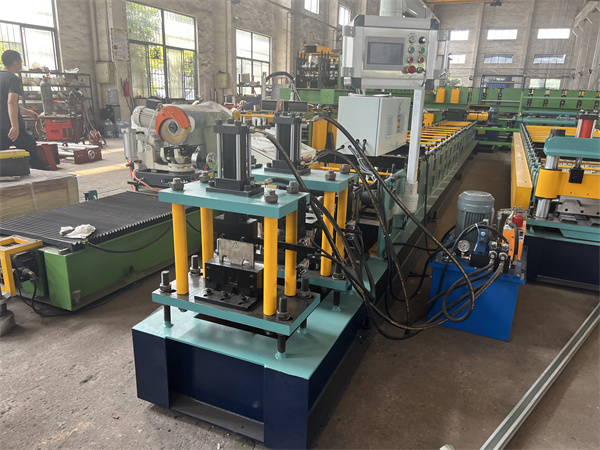
5. Облицовочный валковый формовочный станок
Знакомство с облицовочной роликовой формовочной машиной
Облицовочная вальцовочная машина предназначена для производства облицовочных панелей, используемых для наружной обшивки стен в жилых, коммерческих и промышленных зданиях. Облицовочные панели обеспечивают изоляцию, защиту от атмосферных воздействий и эстетическую привлекательность ограждающих конструкций здания. Облицовочная вальцовочная машина позволяет эффективно производить эти панели с различными профилями и отделкой.
Рабочий процесс и преимущества
Станок для формирования облицовочных валков работает путем непрерывной подачи металлической полосы через несколько валковых станций. Каждый валок выполняет определенные операции сгибания и формовки, постепенно придавая полосе желаемый профиль облицовки. Машина позволяет изменять ширину, длину, толщину и качество поверхности панелей.
Преимущества использования оборудования для формирования облицовочных валов включают:
- Универсальность: Машина может производить широкий спектр профилей облицовочных панелей, включая ребристые, гофрированные, стоячий шов и другие. Такая универсальность позволяет создавать разнообразные варианты дизайна в соответствии с различными архитектурными стилями.
- Эффективность: Облицовочные вальцовочные станки обеспечивают высокую скорость производства, гарантируя эффективность производственных процессов и соблюдение сроков реализации проектов.
- Экономическая эффективность: Рулонное формование предлагает экономически эффективное решение для производства облицовочных панелей, минимизируя отходы материала и снижая трудозатраты по сравнению с другими методами изготовления.
- Постоянное качество: Машина обеспечивает постоянное качество и точность размеров облицовочных панелей, отвечающих отраслевым стандартам и спецификациям.
Общие области применения и используемые материалы
Облицовочные панели, произведенные на валковых формовочных машинах, находят применение в различных отраслях промышленности и типах зданий:
- Коммерческое и жилое строительство: Облицовочные панели широко используются при строительстве коммерческих зданий, жилых комплексов и жилищных проектов. Они обеспечивают защиту от атмосферных воздействий, изоляцию и повышают визуальную привлекательность экстерьера здания.
- Промышленные объекты: В промышленных зданиях, складах и производственных помещениях часто используются облицовочные панели благодаря их долговечности, низкой потребности в обслуживании и устойчивости к суровым условиям окружающей среды.
- Архитектурные проекты: Облицовочные панели используются в архитектурных проектах для создания уникальных фасадных конструкций, добавляя глубину, текстуру и визуальный интерес к облицовке здания.
Материалы, обычно используемые для облицовочных панелей, включают сталь, алюминий, нержавеющую сталь и композитные материалы. Выбор материала зависит от таких факторов, как желаемая эстетика, долговечность и конкретные требования проекта.
Факторы, которые необходимо учитывать при выборе оборудования для формирования облицовочных валов
При выборе вальцовочного станка для формирования облицовки учитывайте следующие факторы:
- Разработка и настройка профиля: Оцените способность машины производить желаемые профили облицовочных панелей, включая возможность настройки размеров, рисунка ребер и отделки поверхности.
- Совместимость материалов: Убедитесь, что станок может работать с материалами, которые вы планируете использовать для облицовки панелей, учитывая их толщину, прочность и требования к покрытию поверхности.
- Скорость и мощность производства: Оцените скорость и производительность машины, чтобы соответствовать срокам выполнения вашего проекта и требованиям к производительности.
- Контроль качества и точность: Ищите машину, которая обеспечивает точное формирование и стабильное качество облицовочных панелей, сводя к минимуму отходы и повторную обработку.
- Простота эксплуатации и обслуживания: Рассмотрите удобный интерфейс машины, простоту настройки и требования к техническому обслуживанию, чтобы оптимизировать производительность и минимизировать время простоя.
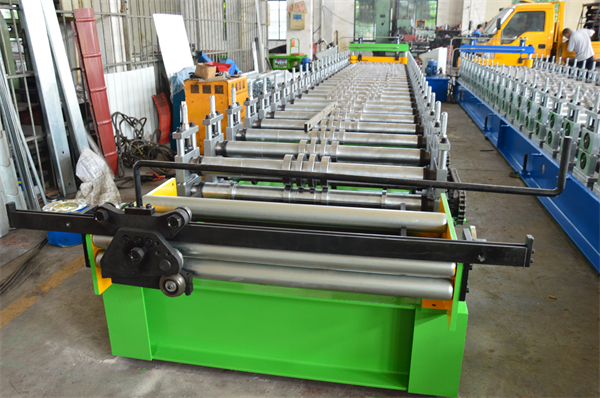
6. Машина для формовки рулонов фланцев
Обзор рулоноформовочного станка для оклада
Рулоноформовочная машина специально разработана для производства металлических окладов, используемых в строительстве и кровельных работах. Оклады - это тонкие полосы металла, которые используются для гидроизоляции и защиты стыков, швов и переходов в крышах, стенах и других элементах здания. Рулоноформовочная машина позволяет эффективно производить эти металлические оклады нестандартной формы.
Механизм работы и преимущества
Вальцовочная машина для формирования оклада работает путем постепенного сгибания и придания металлической полосе требуемого профиля оклада. Машина оснащена несколькими валковыми станциями, каждая из которых выполняет определенные операции по гибке и формовке. Преимущества использования вальцовочного станка для формирования оклада включают в себя:
- Индивидуальные мигающие профили: Машина позволяет изготавливать оклады различных форм, размеров и конфигураций в соответствии с конкретными требованиями проекта.
- Постоянное качество: Вальцепрокатные станки для формирования окладов обеспечивают постоянное качество и точность размеров окладов, соответствующие отраслевым стандартам и спецификациям.
- Эффективность затрат и времени: Рулонная формовка окладов обеспечивает экономию средств и времени по сравнению с традиционными методами изготовления. Машина может производить оклады в непрерывном процессе, минимизируя отходы материала и снижая трудозатраты.
- Широкий спектр материалов: Вальцовочные станки могут работать с различными материалами, такими как алюминий, сталь, медь или оцинкованный металл, что обеспечивает гибкость в выборе материала в зависимости от потребностей проекта.
Применение рулонных формовочных машин для окладов
Оклады, изготовленные на рулоноформовочных машинах, имеют широкий спектр применения в строительной отрасли:
- Кровельные работы: Оклады обычно используются в кровельных системах для обеспечения водонепроницаемых уплотнений на переходах крыши, ендовах, дымоходах, мансардных окнах и вентиляционных отверстиях.
- Стеновые системы: Облицовки используются в стеновых системах для защиты и герметизации швов между различными стеновыми материалами, такими как сайдинг, облицовка или каменная кладка.
- Установка окон и дверей: Оклады имеют решающее значение при установке окон и дверей для предотвращения проникновения воды и обеспечения надлежащей герметизации вокруг проемов.
- Гидроизоляция: Оклады играют жизненно важную роль в гидроизоляции, обеспечивая целостность и долговечность ограждающих конструкций.
Важные факторы, которые необходимо учитывать при покупке рулонной формовочной машины для оклада
При выборе валковой листогибочной машины учитывайте следующие факторы:
- Гибкость мигающего профиля: Оцените способность станка производить различные профили оклада, включая нестандартные формы и размеры, необходимые для конкретных проектных нужд.
- Совместимость материалов: Убедитесь, что машина может работать с материалами, обычно используемыми для окладов, такими как алюминий, сталь или медь, с требуемой толщиной и прочностью.
- Скорость и эффективность производства: Оцените скорость и эффективность производства машины для соблюдения сроков проекта и производственных требований.
- Настройка инструментальной оснастки: Проверьте, позволяет ли машина легко регулировать и настраивать оснастку для валков, чтобы приспособить их к различным конструкциям профиля оклада.
- Контроль качества и точность: Ищите машину, которая обеспечивает высококачественное формование и постоянную точность при изготовлении окладов, сводя к минимуму ошибки и переделки.
- Простота эксплуатации и обслуживания: Рассмотрите удобный интерфейс машины, простоту настройки и требования к техническому обслуживанию, чтобы обеспечить бесперебойную работу и минимизировать время простоя.
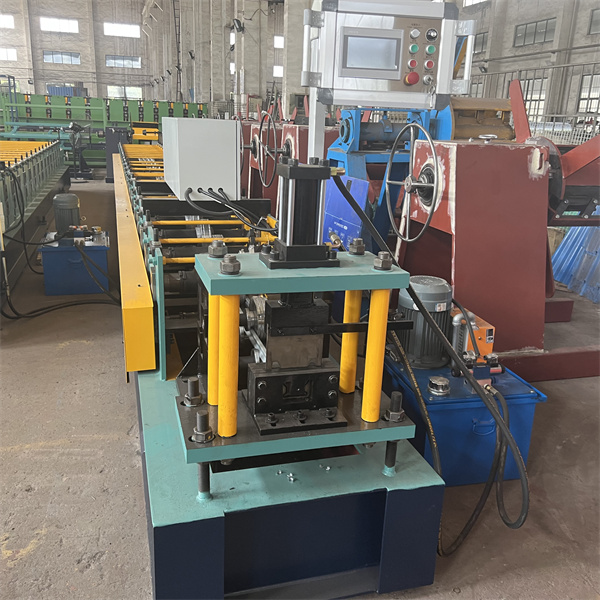
7. Станок для формирования рулонов настила пола
Введение в машину для формирования настила пола
Вальцовочная машина для формирования настила пола предназначена для производства панелей настила пола, используемых в строительстве, в частности, в системах композитных полов. Панели настила пола используются в качестве структурных компонентов для обеспечения поддержки, стабильности и огнестойкости зданий. Вальцовочный станок для настила пола позволяет эффективно производить эти панели с точными размерами и высококачественной отделкой.
Принцип работы и особенности
Вальцовочная машина для формирования настила пола работает путем непрерывной подачи металлической полосы через ряд вальцовочных станций. Каждая станция выполняет определенные операции сгибания и придания формы, постепенно формируя металлическую полосу в желаемый профиль настила. Основные характеристики вальцовочного станка для формирования настила пола включают:
- Многочисленные рулонные станции: Машина оснащена несколькими станциями прокатки для достижения требуемой формы и размеров профиля. Количество станций может варьироваться в зависимости от сложности и дизайна профиля настила пола.
- Эффективное использование материалов: Вальцовочные станки для формирования настила пола оптимизируют использование материала, минимизируя отходы и снижая затраты в процессе производства.
- Скорость и производительность: Эти машины предназначены для высокоскоростного производства, обеспечивая эффективность производственных процессов и соблюдение сроков реализации проектов.
- Контроль качества и точность: Вальцевые станки для формирования настила пола обеспечивают постоянное качество и точность размеров панелей настила пола, соответствуя отраслевым стандартам и спецификациям.
Применение и преимущества
Профили настила пола, производимые на вальцовочных станках, находят широкое применение в строительной отрасли, особенно в системах композитных полов. Некоторые преимущества использования вальцовочных станков для производства настила пола включают:
- Структурная прочность: Панели перекрытия обеспечивают структурную стабильность и поддержку зданий, способствуя общей прочности и несущей способности конструкции.
- Огнестойкость: Панели настила пола часто проектируются с учетом требований огнестойкости, что повышает безопасность и соответствие здания требованиям.
- Простота установки: Конструкция профилей настила пола позволяет легко и эффективно производить монтаж, сокращая время строительства и трудозатраты.
- Универсальность: Профили настила пола могут быть изготовлены на заказ с учетом различной длины пролета, требований к нагрузке и архитектурных характеристик, что обеспечивает универсальность конструкции и применения.
- Интеграция с другими системами: Панели настила пола могут легко интегрироваться с другими строительными системами, такими как бетонные плиты, изоляция, механические и электрические коммуникации.
Ключевые факторы, которые необходимо учитывать при выборе машины для формирования рулонов настила пола
При выборе вальцовочного станка для настила пола учитывайте следующие факторы:
- Разработка и настройка профиля: Оцените возможности станка по производству конкретных профилей настила пола, необходимых для вашего проекта, включая длину пролетов, рисунок ребер и другие проектные спецификации.
- Совместимость материалов: Убедитесь, что машина может работать с материалами, обычно используемыми для изготовления панелей настила пола, такими как сталь или оцинкованная сталь, с требуемой толщиной и прочностью.
- Скорость и мощность производства: Оцените скорость и производительность машины, чтобы соответствовать срокам и требованиям вашего проекта.
- Контроль качества и точность: Ищите машину, которая обеспечивает высококачественное формование и точность размеров панелей настила пола, сводя к минимуму ошибки и повторную обработку.
- Простота эксплуатации и обслуживания: Рассмотрите удобный интерфейс машины, простоту настройки и требования к техническому обслуживанию, чтобы оптимизировать производительность и минимизировать время простоя.
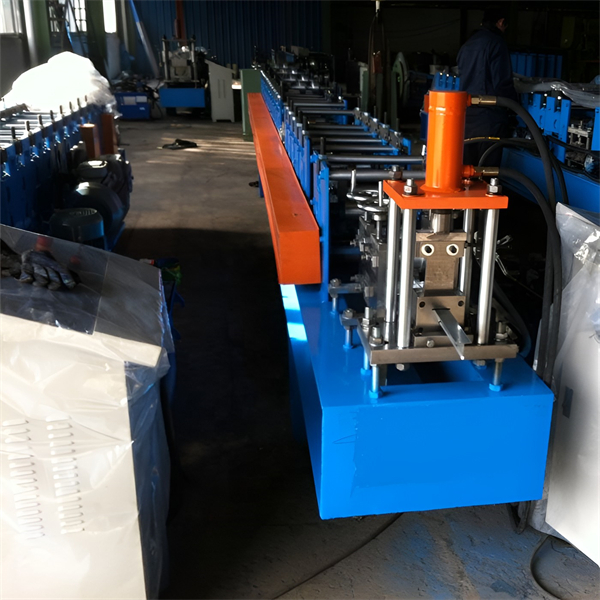
8. Заключение
Вальцовочные станки играют важную роль в производстве металлических профилей, используемых в различных отраслях промышленности. В этой статье мы рассмотрели различные типы вальцовочных станков, включая двухслойные вальцовочные станки, фризовые вальцовочные станки, облицовочные вальцовочные станки, окладные вальцовочные станки и вальцовочные станки для настила пола. Каждый тип служит определенным целям и предлагает уникальные преимущества с точки зрения эффективности, настройки и контроля качества.
Понимание принципов работы, особенностей, применения и соображений, связанных с этими машинами, позволит вам принимать обоснованные решения при выборе валковой машины, соответствующей вашим производственным требованиям. Если вам необходимо производить несколько профилей одновременно, создавать точные фризовые или облицовочные панели, изготавливать нестандартные оклады или производить структурные настилы для пола, то в любом случае вы найдете вальцепрокатный станок для удовлетворения ваших потребностей.
Инвестиции в высококачественную вальцовочную машину могут значительно расширить ваши производственные возможности, оптимизировать производственные процессы и способствовать успеху вашего бизнеса.
Часто задаваемые вопросы
1.В чем разница между однослойными и двухслойными вальцовочными станками?
2.Сколько времени занимает настройка вальцепрокатного станка под конкретный профиль?
3.Подходят ли вальцовочные станки для мелкосерийного производства?
4.Могут ли валковые машины быть настроены на конкретные формы и размеры?
5.Какое техническое обслуживание требуется для вальцовочных станков?
